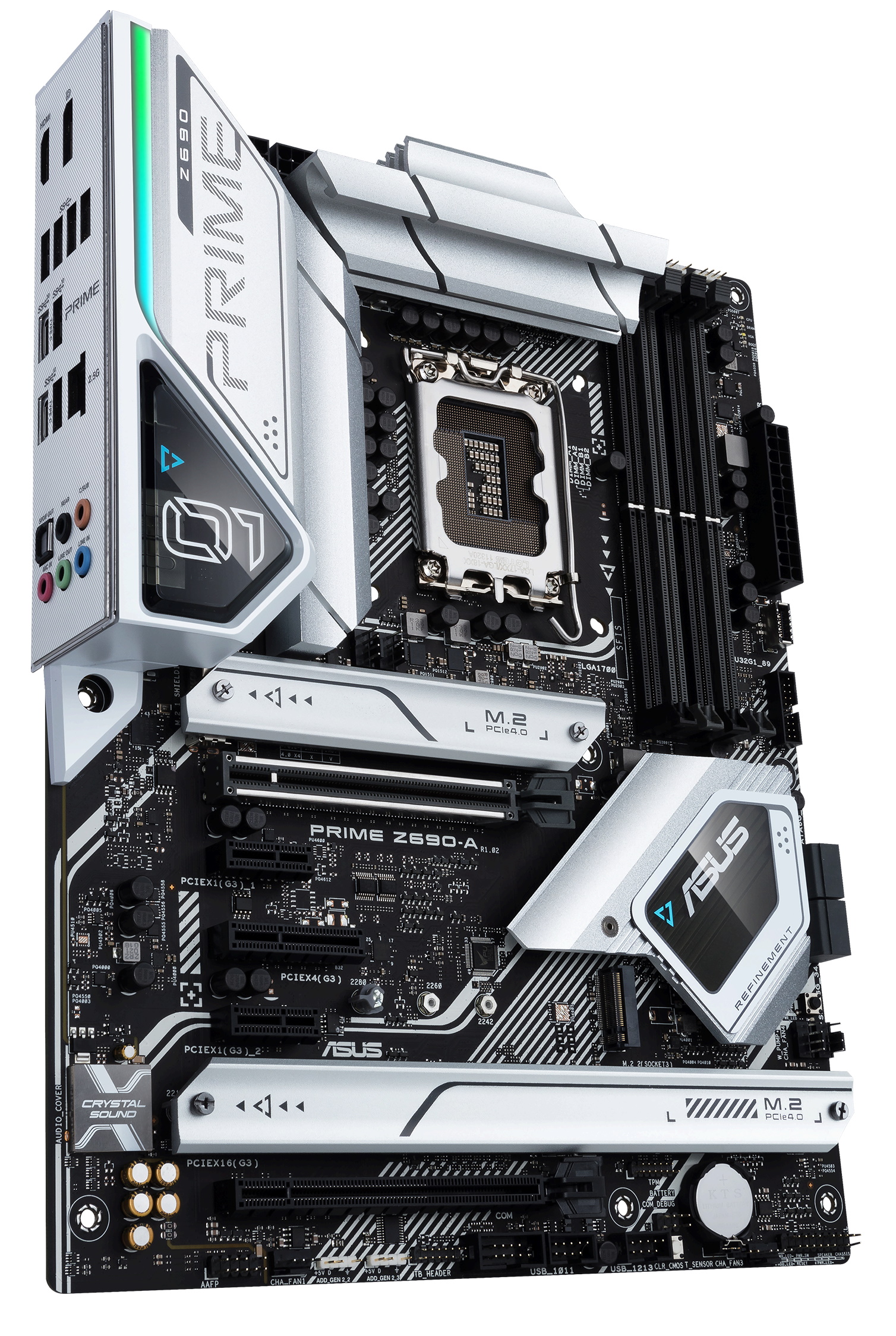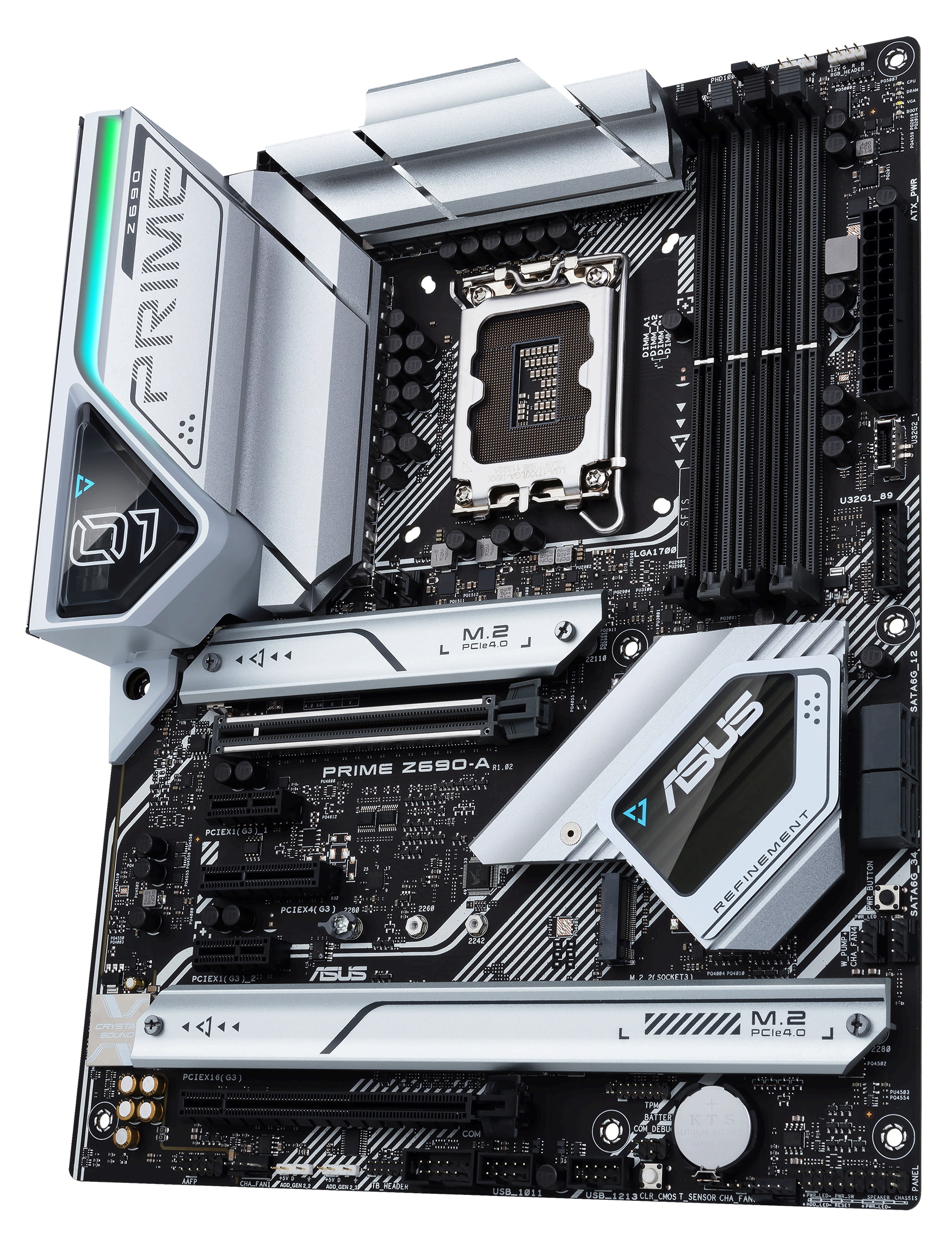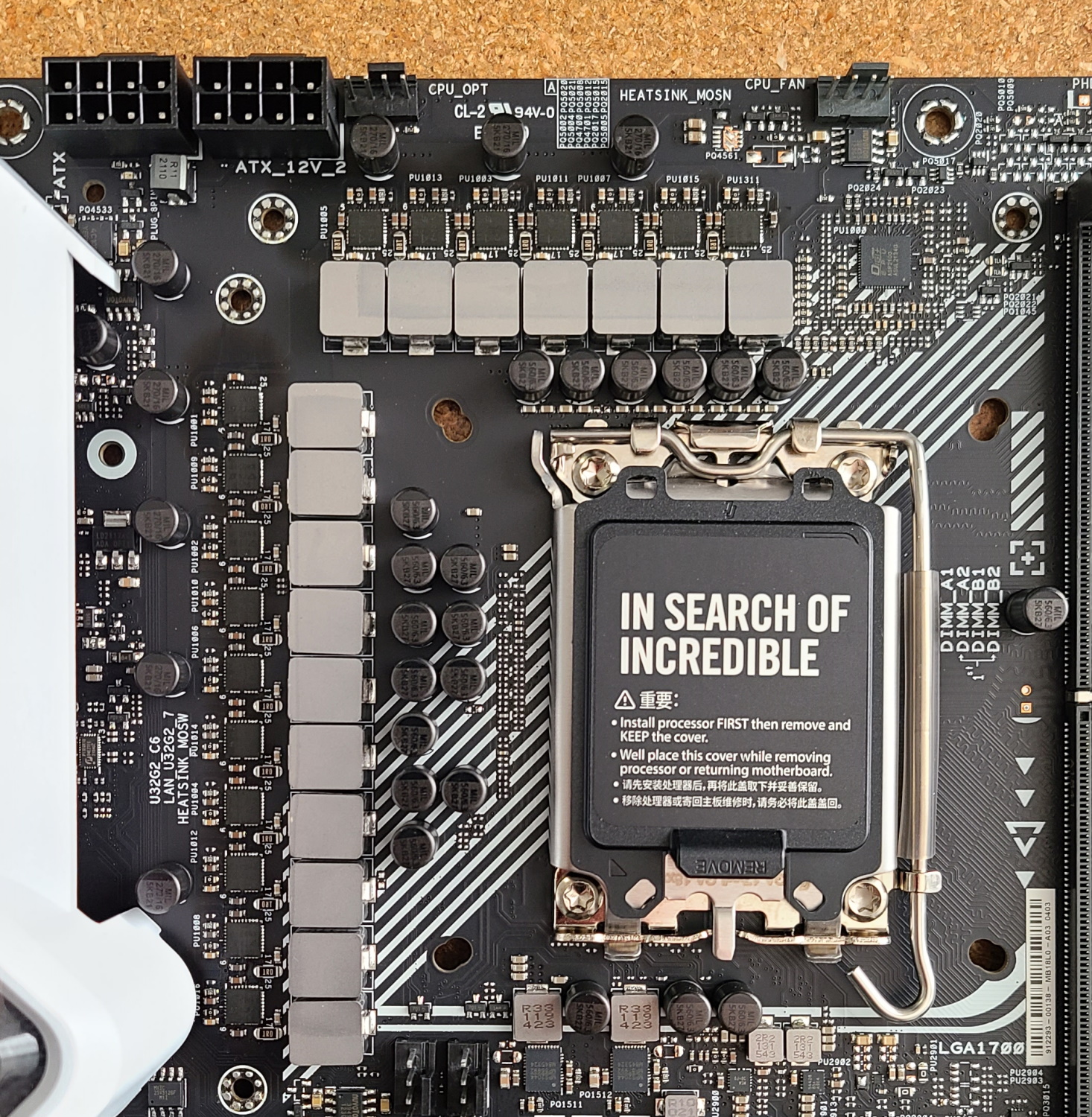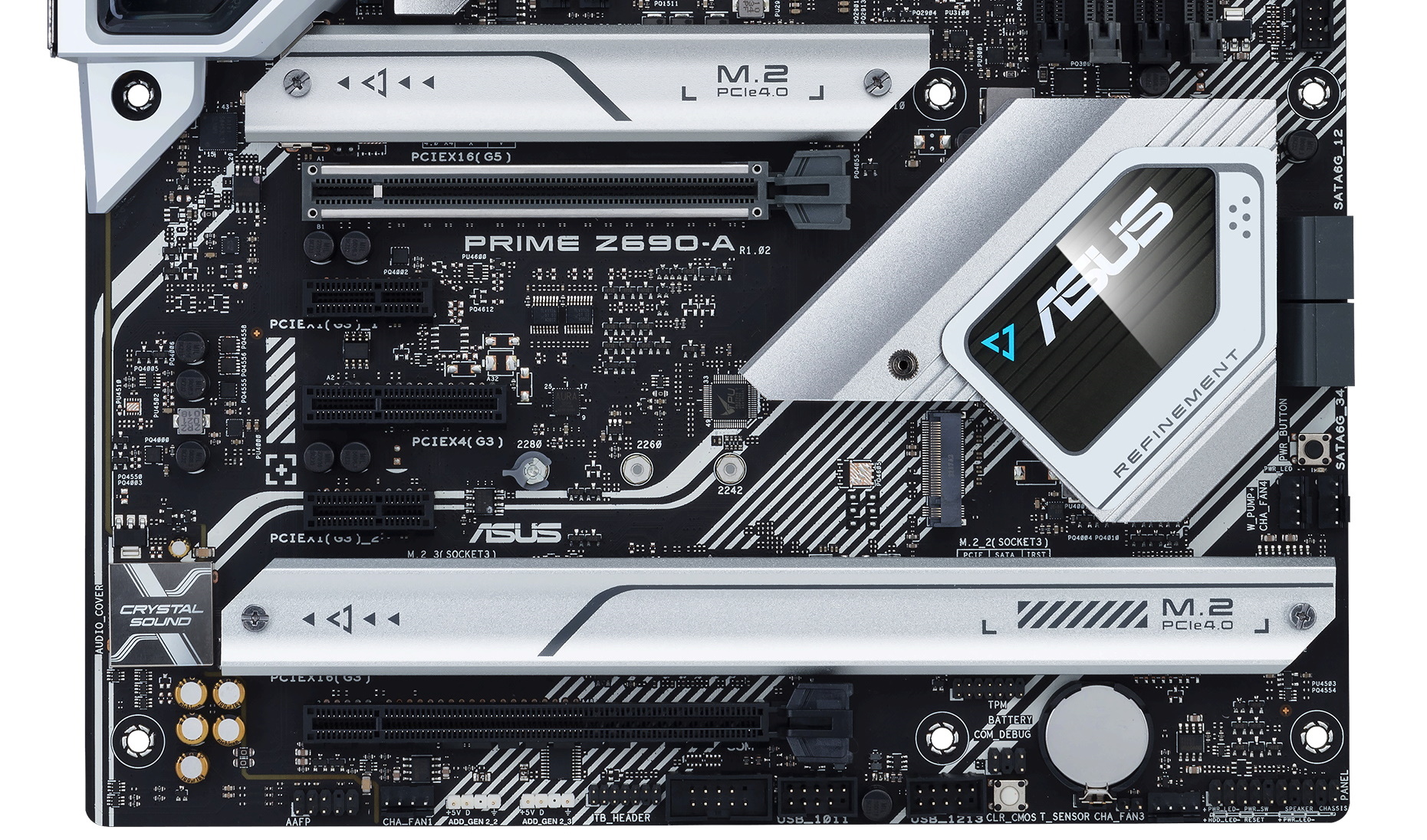Tom's Hardware Verdict
At $279.99, the Asus Prime Z690-A includes capable power delivery, four M.2 sockets, Intel-based 2.5 GbE (but no Wi-Fi) and space shuttle-like styling. If you’re in the market for a sub-$300 board and don’t need lots of USB or SATA ports, the Prime Z690-A is worth considering.
Pros
- +
+ 4x M.2 sockets
- +
+ Q-Latch for M.2
- +
+ Two USB-C ports
- +
+ No lane sharing with storage
Cons
- -
Just Eight USB and four SATA ports
- -
No integrated Wi-Fi
Why you can trust Tom's Hardware
The Asus Prime Z690-A hails from the budget side of the pricey Z690 platform, offering up space shuttle looks alongside adequate power delivery and cooling. On their Z690 SKUs, Asus tweaked the appearance of the previous generation Z590 Prime boards, updated connectivity and improved power delivery. The result with the Prime Z690-A specifically is a well-equipped and fairly priced ATX motherboard for your Alder Lake processor.
The Prime Z690-A sports PCIe 5.0 and DDR5 support, four M.2 sockets with Q-Latch, a last-generation flagship audio codec, a 20 Gbps Type-C port and a 2.5 GbE – but no integrated Wi-Fi. It’s a full-featured motherboard at a reasonable $279 price, but the space-shuttle-inspired design and the low number of USB Type-A ports (six) on the rear IO may not work for everyone.
Performance on the Prime Z690-A was average to slightly above across most tests. Our benchmarking results for gaming were also average, as was memory testing with AIDA. Power use was also lower than most Z690 boards we’ve tested, though it’s not like you’ll notice it on your electric bill. In short, performance was not an issue on the Prime during our testing. Along those lines, with a few BIOS tweaks, overclocking went perfectly with this inexpensive board running our flagship Core i9-12900K processor well outside of specifications. Read on as we delve deep into the board’s features, our opinion from testing and use, and see how it stacks up to the best motherboards. But first, here’s a complete list of the Asus Prime Z690-A specifications from Asus’ website.
Specifications: Asus Prime Z690-A
| Socket | LGA1700 |
| Chipset | Z690 |
| Form Factor | ATX |
| Voltage Regulator | 17 Phase (16+1 60A SPS MOSFETs for Vcore) |
| Video Ports | (1) HDMI (v2.1) |
| Row 5 - Cell 0 | (1) DisplayPort (v1.4) |
| USB Ports | (1) USB 3.2 Gen 2x2 Type-C (20 Gbps) |
| Row 7 - Cell 0 | (1) USB 3.2 Gen 2 Type-C (10 Gbps) |
| Row 8 - Cell 0 | (2) USB 3.2 Gen 2 (10 Gbps) |
| Row 9 - Cell 0 | (4) USB 3.2 Gen 1 (5 Gbps) |
| Network Jacks | (1) 2.5 GbE |
| Audio Jacks | (5) Analog + SPDIF |
| Legacy Ports/Jacks | ✗ |
| Other Ports/Jack | ✗ |
| PCIe x16 | (1) v5.0 (x16) |
| Row 15 - Cell 0 | (1) v3.0 (x4) |
| PCIe x8 | ✗ |
| PCIe x4 | (1) v. 3.0 (x4) |
| PCIe x1 | (2) v. 3.0 (x1) |
| CrossFire/SLI | Supports AMD CrossFire |
| DIMM slots | (4) DDR5 6000+(OC), 128GB Capacity |
| M.2 slots | (1) PCIe 4.0 x4 (64 Gbps) / PCIe (up to 110mm) |
| Row 22 - Cell 0 | (1) PCIe 4.0 x4 (64 Gbps) / PCIe (up to 80mm) |
| Row 23 - Cell 0 | (1) PCIe 4.0 x4 (64 Gbps) / PCIe (up to 80mm) |
| Row 24 - Cell 0 | (1) PCIe 4.0 x4 (64 Gbps) / PCIe + SATA (up to 80mm) |
| Row 25 - Cell 0 | Supports RAID 0/1/5 |
| U.2 Ports | ✗ |
| SATA Ports | (4) SATA3 6 Gbps (Supports RAID 0/1/5/10) |
| USB Headers | (1) USB v3.2 Gen 2, Type-C (10 Gbps) |
| Row 29 - Cell 0 | (1) USB v3.2 Gen 1 (5 Gbps) |
| Row 30 - Cell 0 | (2) USB v2.0 (480 Mbps) |
| Fan/Pump Headers | (8) 4-Pin (CPU, CPU, CPU OPT, AIO, Chassis) |
| RGB Headers | (3) aRGB (3-pin) |
| Row 33 - Cell 0 | (1) RGB (4-pin) |
| Diagnostics Panel | Q-LEDs |
| Q-LEDs | Power and Clear CMOS buttons |
| SATA Controllers | ✗ |
| Ethernet Controller(s) | (1) Intel I225-V (2.5 Gbps) |
| Wi-Fi / Bluetooth | ✗ |
| USB Controllers | ASMedia ASM1442X |
| HD Audio Codec | Realtek ALC1220A |
| DDL/DTS | ✗ / DTS: X Ultra |
| Warranty | 3 Years |
Asus Prime Z690-A Accessories
Inside the box, Asus includes all of the basic accessories you’d expect, including SATA cables, Q-latch packages (plastic latches that mean you don’t have to fumble with the tiny M.2 screws), and a driver disk. While the accessory stack isn’t the most comprehensive, it should get you started without an unexpected trip to the store. Below is a complete list of the included extras.
- Quick Installation Guide, Support CD
- (2) SATA Data Cables
- M.2 rubber package
- Q-connector
- M.2 Q-Latch package
Design and Features of the Asus Prime Z690-A



Asus designed the Prime Z690-A with a black PCB and contrasting silver and white heatsinks on all the hot bits. The sole RGB lighting area is tucked up beneath the left VRM heatsink, in a small vertical strip. The light is nice and saturated, but it won’t flood the inside of your case with light.
The silver VRM heatsinks are large and heavy and at least look like they’ll do the job (they do, but more on that later). Three of the four M.2 sockets use silver/grey heatsinks along with the chipset, which contrasts against the PCB. The look doesn’t scream premium with so much PCB showing, but the “space-shuttle-inspired design elements” look good and fit nicely with many build themes, especially when used inside a white chassis. That said, the look can be a bit polarizing as some just want a nice design and not a built-in theme.
As we look at the top half of the black PCB, we’ll start on the left side and the large silver VRM heatsinks. While there aren’t a lot of cutouts to increase surface area, the mass of these should help keep the VRMs below running well within specification (and they do, which we’ll see later in testing). The left heatsink reaches out over the rear IO area, while below it is a translucent smoked grey accent piece matching the shuttle theme. There are two 8-pin EPS connectors above the heatsinks to power the CPU, one of which is required.
Get Tom's Hardware's best news and in-depth reviews, straight to your inbox.
The socket area is relatively busy, with a lot of capacitors surrounding it. A pattern of white lines stenciled on the board also cuts through this area. To the right of the socket, we run into four unreinforced, single-side locking DRAM slots. The Prime supports up to 128GB of DDR5 RAM with speeds listed to DDR5 6000, one of the lower values we’ve seen. Still, that’s over 1200 MHz faster than the maximum rated platform speed (4800 MHz). Your mileage may vary reaching these speeds, as you need the right memory kit and controller to get there.
Just above the RAM slots and the top VRM heatsink is the first (of eight) 4-pin fan/pump headers. All CPU and Chassis fans (labeled CPU_XXX and CHA_XXX) are Q-Fan controlled and output up to 1A/12W. The AIO_PUMP and W_PUMP+ headers run full speed by default. The AIO header outputs 1A/12W, while the PUMP Header supports up to 3A/36W. There are plenty of headers to run your air- or water-cooled system from the motherboard, with control coming from the AI Suite or Dragon Center software.
If the small strip over the IO area isn’t enough RGB lighting, the Prime Z690-A has a few headers to add your own strips or other RGB parts. Up top above the DRAM slots are 3-pin ARGB and 4-pin RGB headers, with the other two (both 3-pin ARGB) located on the bottom edge of the board.
Along the right edge, working our way down, we run into the 4-LED Q-Code (your only notification if something went wrong during POST) and a 24-pin ATX connector to power the board. Just below are the front panel USB ports. First, we hit a USB 3.2 Gen 2 (10 Gbps) Type-C header and then a 19-pin USB 3.2 Gen 1 (5 Gbps) Type-A header. Since Prime Z690-A only has six total Type-A (plus two Type-C) ports, users may need to use the front ports out of necessity instead of convenience.
This board sees a worthwhile upgrade from the Z590 version for power delivery. Here Asus implemented a 16+1 phase VRM (versus 14+1 on Z590). Power comes from the EPS connector(s) and onto the Digi+ VRM chip, an ASP2100. We couldn’t find all the details, but we expect the board uses Asus’ “teamed” VRM configuration, where each channel on the PWM controller sends power to two MOSFETs, but without a phase doubler in the mix. Power then moves to the 16 Vishay Sic643 60A MOSFETs. The 960A available is a huge increase over the Z590 version (700A), and it handled our flagship Intel i9-12900K without concern. You’ll run out of cooling on the CPU before these VRMs hold you back.
Moving down to the bottom portion of the board, we find a lot more exposed PCB than on pricier boards, but that’s expected. Outside of a Faraday cage, the audio section is fully exposed. Three of four M.2 sockets sport simple heatsinks on them, while one doesn’t have any. Starting with the audio, hidden under the Crystal Sound cover is the last generation’s flagship, a Realtek ALC1220 codec and a few gold Nichicon audio capacitors. Priced where it is, I didn’t expect to see the latest and greatest here. Most users will be satisfied with this codec, but you won’t find any DACs or fancy amplifiers.
Moving to the middle of the board, we’ll look at the PCIe slots first. There are two full-length slots, two x1 size slots, and one x4. The primary graphics slot (top) is reinforced and runs at PCIe 5.0 x16. The bottom full-length slot sources its lanes from the chipset and runs at a maximum of PCIe 3.0 x4. The other three slots receive their lane allocation from the chipset and run their labeled speeds (PCIe 3.0 x1 and PCIe 3.0 x4). This configuration supports Crossfire technology. SLI users are out of luck, but multi-card setups for gaming have effectively been dead or dying for years.
Scattered among the PCIe slots are four M.2 sockets. All M.2 sockets run at a maximum of PCIe 4.0 x4 (64 Gbps) speeds. M.2_1 (top) and M.2_3 (bottom left) support 110mm PCIe drives. M.2_2 (socket without a heatsink) supports PCIe modules up to 80mm while M.2_4 supports up to 80mm PCIe and SATA-based M.2 drives. Since the Prime Z690-A only has four SATA ports, there isn’t any lane sharing with the M.2 sockets. In short, you can run any combination of M.2 modules and populate all of the SATA ports (which adds up to eight drives total) without worrying about a disabled port. Continuing right, we glide past the chipset heatsink and hit the right edge. There we find four SATA ports (supports RAID0/1/5/10), a simple power button and two 4-pin fan headers.
Across the bottom are several headers, including USB ports and RGB. Below is a complete list, from left to right:
- Front panel audio
- 4-pin Chassis fan header
- (2) 3-pin ARGB headers
- Thunderbolt AIC header
- COM header
- (2) USB 2.0 headers
- Clear CMOS button
- Temperature sensor header
- 4-pin Chassis fan header
- Front panel header
Shifting focus to the critical rear IO area, we see a pre-installed IO plate matching the Prime Z690 theme. The white background has lines running throughout. Each port is labeled in a darker color, making them easy to identify.
There are eight total USB ports around back: one 20 Gbps and one 10 Gbps Type-C port, two 10 Gbps Type-A ports and four 5 Gbps ports. The six Type-A ports may not be enough for some users, however. Please be sure you can utilize the additional front panel ports if this is a concern. On the video front, Asus has a Displayport (v1.4) and HDMI (v2.1) for use with the integrated graphics found on many Intel processors. Also, on the rear IO, you’ll find the Intel 2.5 GbE port (there is no Wi-Fi on this board) and the common five-plug plus SPDIF audio stack.
MORE: Best Motherboards
MORE: How To Choose A Motherboard
MORE: All Motherboard Content

Joe Shields is a staff writer at Tom’s Hardware. He reviews motherboards and PC components.
-
perpetual98 I think you've got some duplicate paragraphs there at the end. Or my browser is being dumbReply -
Co BIY Replyperpetual98 said:I think you've got some duplicate paragraphs there at the end. Or my browser is being dumb
I thought I was just tired.
Great board for review.
For me 6 USB plus front headers is plenty but I'm probably not a power user. USB is easy (and cheap) to add by card if needed later. 4 x M.2 is great.
I would like to see integrated Wi-Fi. (mainly for the Bluetooth) -
abepcnt i am having a very bad time with this board, the 4 USBs 3.1 are not working. i contacted Asus customer service here in Sydney, they are very unprofessional and they have no idea about the M/B, they gave me a very stupid answer and they asked me to pay $110 for repair, this board is 2 weeks old and still under the warranty, i do not recommended it at all.Reply



